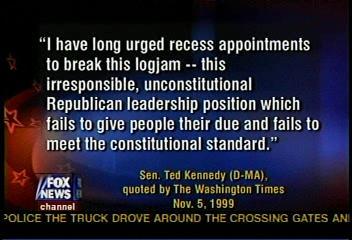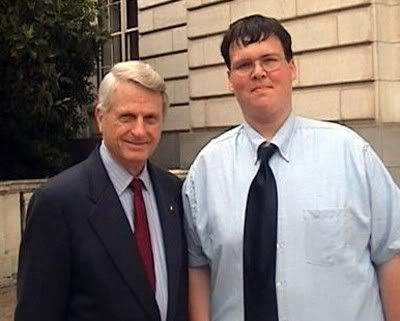Summary
An abortion-rights group is running an attack ad accusing Supreme Court nominee John Roberts of filing legal papers “supporting . . . a convicted clinic bomber” and of having an ideology that “leads him to excuse violence against other Americans” It shows images of a bombed clinic in Birmingham , Alabama .
The ad is false.
And the ad misleads when it says Roberts supported a clinic bomber. It is true that Roberts sided with the bomber and many other defendants in a civil case, but the case didn't deal with bombing at all. Roberts argued that abortion clinics who brought the suit had no right use an 1871 federal anti-discrimination statute against anti-abortion protesters who tried to blockade clinics. Eventually a 6-3 majority of the Supreme Court agreed, too. Roberts argued that blockades were already illegal under state law.
The images used in the ad are especially misleading. The pictures are of a clinic bombing that happened nearly seven years after Roberts signed the legal brief in question.
Analysis
NARAL Pro-Choice America released a new ad focusing on John Roberts, President Bush's nominee to fill Sandra Day O'Connor's vacant Supreme Court position, called "Speaking Out," on August 8. NARAL said it plans to buy half a million dollars worth of airtime in coming weeks on national cable networks, as well as well as on networks in Maine and Rhode Island.
The ad shows images of a bombed clinic before a woman identified as Emily Lyons appears on screen, saying "I nearly lost my life." An announcer says, "Supreme Court nominee John Roberts filed court briefs supporting violent fringe groups and a convicted clinic bomber".The announcer then urges viewers to "call your Senators" and "tell them to oppose John Roberts" because we "can't afford a Justice whose ideology leads him to excuse violence against other Americans."
A False Implication
In words and images, the ad conveys the idea that Roberts took a legal position excusing bombing of abortion clinics, which is false. To the contrary, during the Reagan administration when he was Associate Counsel to the President, Roberts drafted a memo saying abortion-clinic bombers "should be prosecuted to the full extent of the law." In the 1986 memo, Roberts called abortion bombers "criminals" and "misguided individuals," indicating that they would get no special treatment regarding requests for presidential pardons. Reagan in fact gave no pardons to abortion-clinic bombers.
The 1986 draft is on file at the Reagan library. The White House furnished a copy to FactCheck.org. (See "supporting documents" at right.)
Seven Years Earlier
The ad fails to mention that the "court briefs" it mentions are actually from nearly seven years before the abortion clinic bombing talked about in the ad. The woman in the ad, Emily Lyons, was injured by a bomb blast at the New Woman/All Women Health Clinic in Birmingham on January 28, 1998 that also killed an off-duty police officer. The bomber was Eric Rudolph, who was captured in May 2003 after a five-year manhunt. Rudolph pleaded guilty and in July 2005 was sentenced to two consecutive life terms without parole.
The brief that Roberts signed, and on which the NARAL ad is based, is from another matter entirely. It is dated April 11, 1991. Furthermore, it is from a civil lawsuit brought by abortion clinics against protesters who were blockading the clinics. Bombing was not an issue.
Supporting Anti-abortion Groups?
The ad contends that Roberts "filed court briefs supporting violent fringe groups and a convicted clinic bomber." Indeed, Roberts' name appears on the "friend of the court" brief in Bray v. Alexandria Women's Health Clinic that the ad shows. But what Roberts was supporting wasn't violence or bombing or even the behavior that was the subject of the lawsuit - blockades of clinics. In fact, Roberts went out of his way to say that the blockaders were trespassing, which is a violation of state law. What Roberts argued was that a federal anti-discrimination law couldn't be used against abortion blockaders because they weren't discriminating against women – they were blockading men, too.
Roberts was serving as Deputy Solicitor General in the administration of George H.W. Bush. He was one of six Justice Department officials who submitted the brief on behalf of the United States government.
The case began as a lawsuit against protestors who hold "antiabortion demonstrations in which participants trespass on, and obstruct general access to" abortion clinics by blocking the entrances and exits. Lawyers for abortion clinics took the position that the protesters conspired to violate the civil rights of women. There was no disagreement that the protestors had committed a state crime by protesting on the private property of clinics. Upon appeal, the question was whether the protestors also violated federal law by intentionally denying women equal protection under the law and prevented them from exercising their constitutional right to interstate travel.
In Roberts' brief, and in oral arguments he made in person before the Supreme Court, the government argued that a particular part of U.S. law (Section 1985(3) of Title 42, which derived from the Ku Klux Klan Act of 1871) applied only to conspiracies to deprive people of civil rights due to racial discrimination, not gender discrimination. They also argued that the protestors did "not aim their anti-abortion activities exclusively at women" but "at anyone, whether male or female, who assists or is involved in the abortion process – doctors, nurses, counselors, boyfriends, husbands and family members, staffs, and others." The court, in a 6-3 decision, ultimately agreed with much of the government's argument, saying that "the characteristic that formed the basis of the targeting" for protest "was not womanhood, but the seeking of abortion," which is entirely voluntary. The court also found that the protestors did not engage in a conspiracy to deprive women of their civil rights.
To be sure, anti-abortion protestors saw the court's decision as a victory. It made them subject only to state actions for simple trespassing on the clinic's private property rather than for federal claims involving civil rights violations, at least as long as the protests stayed non-violent and didn't raise charges of assault or inciting to riot. But the ruling and the argument that led to hardly excuses violence, as the NARAL ad falsely claims. Nowhere in Roberts' court brief or oral arguments does he defend or excuse acts of violence.
Guilt by Association
The ad uses the classic tactic of guilt by association, linking Roberts with "violent fringe groups" and a "convicted . . . bomber" because he made the same legal arguments as they did in the case. But, contrary to the ad's message, Roberts didn't argue in favor of them or their actions.
The "fringe group" in question is Operation Rescue, a zealously antiabortion group that had a history of staging confrontational protests around the country, and which the lawsuit was aimed at stopping. Originally led by Randall Terry, Operation Rescue protesters would stand in front of local abortion clinics, sometimes screaming "Mommy, mommy," waving crucifixes, and pleading with pregnant women to turn away. They sometimes pressed against car doors to keep pregnant women from getting out. Hundreds would go limp to make it more difficult for police to clear them away. More than 40,000 people were arrested in these demonstrations over four years.
Although these methods in some ways mirrored the non-violent tactics used earlier by civil-rights activists, some saw Operation Rescue's actions as relying on the threat of violence, at least. In his dissent, Justice Stevens, describes the protests as instances where “the duly constituted authorities are rendered ineffective, and mob violence prevails.” Justice O’Connor, in her own dissent, spoke of "the threat of mob violence" raised by the blockaders.
The ad also links Roberts to a "convicted clinic bomber." That refers to Michael Bray, one of those named in the lawsuit. (His wife's name came first alphabetically, which is why the case is called Bray vs. Alexandria Women's Health Clinic in the first place). Bray himself had been convicted years earlier, in 1985, of conspiracy and possessing unregistered explosive devices in connection to a series of 10 bombings at abortion clinics in Virginia, Maryland, Delaware, and Washington D.C. He eventually served just under 4 years in prison. In 1993 he wrote a book titled A Time to Kill , which argues that killing abortion providers is morally justified.
Whatever one thinks of Bray, Terry, or Operation Rescue, it is misleading to say that Roberts supported them. He was not their attorney; the protestors had their own attorney, Jay Alan Sekulow, for that. Roberts argued the government's position.
NARAL would have every right to say that Roberts argued for a legal result with which they disagreed. They could also say accurately that many persons, including three Supreme Court justices, also disagreed and saw a threat of "mob violence" going unchecked because of that position. But it is false to suggest that Roberts supported the actions of "violent" groups or clinic bombers because he argued that a law aimed at the Ku Klux Klan could not be used against those who blockade abortion clinics.
Footnote: Soon after the Supreme Court ruled in the case, Congress passed a new law specifically aimed at the blockaders. The 1994 Freedom of Access to Clinics Entrances (FACE) act, signed by President Clinton, makes it a federal crime to use force, "threat of force," or "physical obstruction" to injure, intimidate, or interfere with anyone "obtaining or providing reproductive health services." That act in part gave rise to state legislatures and court systems creating so-called "buffer zones" that force protestors to stay a certain distance away from health clinics, which the Supreme Court has allowed to stand.
--by Matthew Barge

